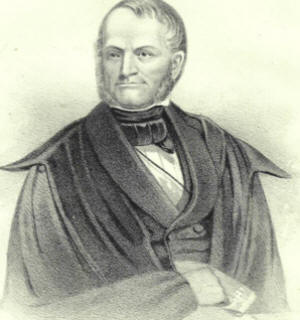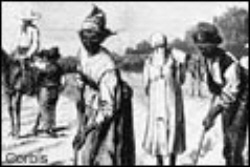Bay City's "Destination Attraction" Should Highlight Anti-Slavery Ties
James G. Birney's Residence Here in the 1840s-1850s May Key Tourism Draw
December 15, 2003
By: Dave Rogers

James G. Birney photo was used for political fund-raising during his 1840 and 1844 candidacies for President on the Liberty Party (abolitionist) ticket.

Slaves work the fields.
Ground was broken earlier this month, Wednesday, Dec. 3, 2003, for the U.S. National Slavery Museum in Fredericksburg, Virginia.
That news item may sound like it has little to do with Bay City, Michigan; but in fact it may have great impact on our future.
Since a major part of our economic development strategy involves tourism, and developing "destination attractions," community, business and government leaders are looking to the past.
Our past includes a short period in the 1840s and 1850s when this was, in effect, the national headquarters of the anti-slavery movement. That status was achieved by virtue of the fact that this was the home of a third party Presidential candidate, James Gillespie Birney, who was the first person to lead a national ticket urging abolition of Negro chattel slavery.
Sixteen years after Birney's second failed effort to become the nation's political leader, a former U.S. Representative from Illinois, namedAbraham Lincoln, used the same platform as Birney had and was elected President.
That fact, and the dramatic events which led up to the election, and the catastropic Civil War which followed that election, are what gives Bay City a right to claim national historic significance.
The architect of the Virginia project, Chien Chung Pei, said he hopes the museum can heal racial rifts left by centuries of human bondage, commenting: "One of the reasons the story of slavery in America has not been told is because there is so much guilt about it."
The guilt, and the denial after the Civil War by the Republican Party that it sprang from abolitionist roots, has buried the distinguished and courageous Mr. Birney in obscurity -- along with Bay City's role in the anti-slavery movement.
But now, 140 years after Lincoln's controversial Emancipation Act, the attitudes of many Americans have changed, and drastically. Congress has directed that slavery, its causes, evils and eradication, be discussed fully. Discussing slavery now is government policy, just as support for slavery was government policy before the Civil War. The National Park Service is the agency leading the effort to inform the public the truths about slavery through interpretive programs at national parks and historic sites.
Several other related museums and centers are springing up with Congressional support, including the National Underground Railroad Freedom Center in Cincinnati,and another slavery museum in Texas.
Other than the fact that Birney, the standard bearer of the Liberty Party in 1840 and again when he lived here in 1844, Bay City has little documentation of its involvement in the anti-slavery movement.
The Chilson House on Midland Street is mentioned as a stop on the Underground Railroad in history books. Birney's brother-in-law, Gerrit Smith, one of the leaders of abolition, financed construction of a house here, which still stands, bythe way. And the hulk of a ship named Gerrit Smith lies buried in the mud of the bottom of the Saginaw River off Veteran's Memorial Park.
Somewhere, in musty historical files, there has to be more information about Bay City's role in the anti-slavery movement, and the Underground Railroad. These issues were not publicly discussed either while the UGRR was operating, for fear of attracting slave catchers, nor after Emancipation, in the general guilt-ridden denial of the political party which launched the movement which resulted in the end of slavery.
Americans for 140 years have continued to hold many of the same attitudes: that Negroes were inferior, that slavery was a benign and patriarchial institution, that slaves were happy with their lot and probably couldn't survive without the "massa's" aid -- in short, the message of Margaret Mitchell's classic book, "Gone With The Wind."
However, to paraphrase Abraham Lincoln, "if anyone thinks slavery is such a good institution, let him try being a slave for a while."
Our job here in Bay City is to serve history with enlightened self interest: promote our involvement in the anti-slavery movement through interpretive programs about Mr. Birney and thus attach our tourism efforts to one of the nation's fastest growing "industries," the story of slavery and its demise.